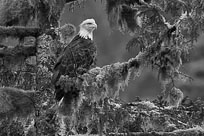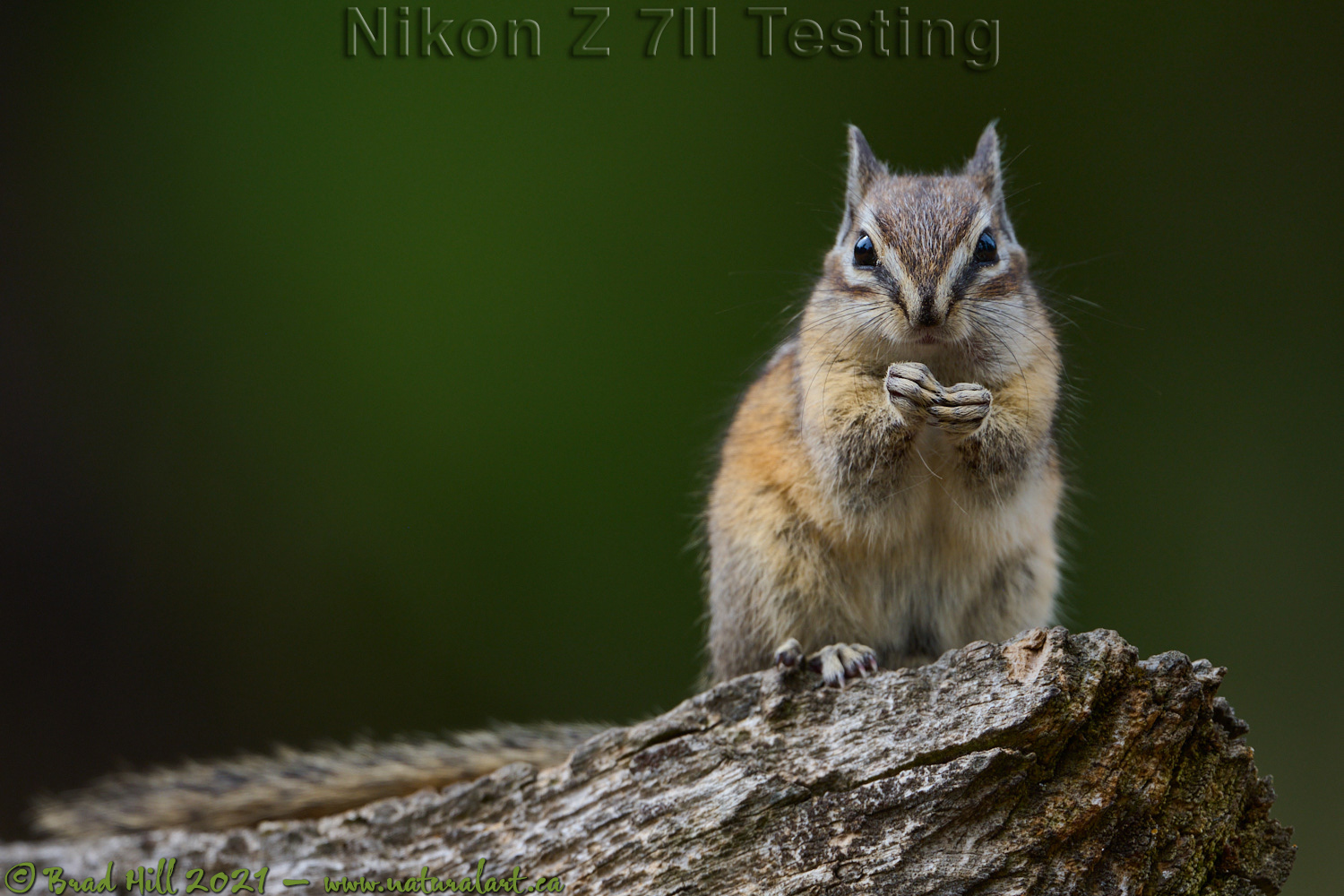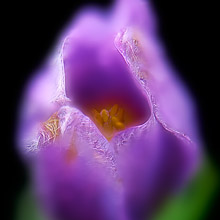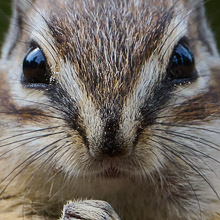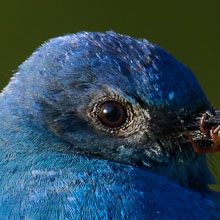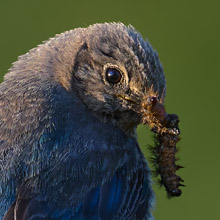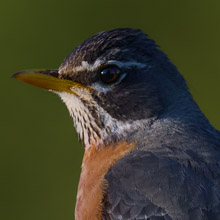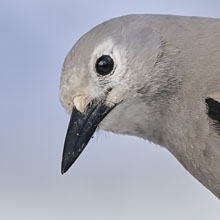Availability: Undetermined - Enquiries?
In the Field
Z 7II Testing - Yellow-pine Chipmunk: Casual and Cute. Findlay Creek Region (East Kootenays), British Columbia, Canada. April 24, 2021.
This is yet one more gallery post relating my experiences with shooting wildlife using the Nikon Z 7II. I captured this Yellow-pine Chipmunk with my Z 7II paired up with the Nikkor 500mm f5.6E PF super-telephoto lens plus TC-14EIII (1.4x) teleconverter. I was laying down on the ground pretty much at eye-level with the chipmunk when I captured the shot...and I shot the image with the lens plus TC combo "wide open" (which with this combination means f8). Even though f8 seems like a "stopped down aperture" that should give you a fair amount of DoF, when you're this close to your subject (this image is just below full-frame, i.e., the crop is negligible) with a focal length of 700mm you have a very thin DoF at pretty much any aperture - and at f8 I only had a cm or two of DoF to play with. You'll see why I'm pointing out the DoF issue below.
This image makes me think of two aspects of the performance of the Z 7II that impact on its suitability for wildlife photography. First, I have already commented on several other image posts about how well the Z 6II performs with F-mount telephoto lenses and zooms when they are combined with F-mount teleconverters. The exact same comments apply when using the Z 7II with long lenses and teleconverters - the performance is EXCELLENT and definitely characterized by having much higher hit rates (of tack sharp shots) than when Nikon DSLR's are used with the same lenses and TC's. I suspect that this strong performance with TC's is related to how mirrorless cameras focus (i.e., directly on the image sensor as opposed to on a secondary "proxy" sensor), so it makes perfect sense that both the Z 6II and Z 7II should behave the same with the same lens/TC combos.
Second...I am and have always been a "compose first, then focus" photographer (as opposed to a "focus first, then recompose" shooter). This means I end up toggling the focus point all over the viewfinder instead of leaving it at or near the center of the viewfinder (and then recomposing after focusing). Because almost the entire viewfinder of the Z 7II is covered by focus points, a focus-point toggler like me can position their subject pretty much anywhere they want and still get a focus point to any part on the subject. Here I focused precisely on the chipmunk's nose pad as I was confident this focus point would allow me to get the front of the eyes in focus as well as keeping the furry paws in focus...and this was definitely ALL I wanted in focus (and that super thin DoF I was talking about above helped me make that happen). And, of course, another thing that gave me the confidence that choosing the nose pad as my focal point would produce the look I wanted in the image is my knowledge of just how deadly accurate the Z 7II focuses. If I was shooting the 500mm PF with a 1.4x TC on a DSLR the chances of me getting this shot would have been diminished (primarily because to focus on the nose pad I'd have been using a focus point on the extreme edge of the focus point array, and none of these points are f8 compatible).
In assessing the overall usefulness of the AF system of the Z 7II (and the Z 6II) for wildlife photography it's important to examine its performance over a broad number of "use cases" one would encounter while shooting wildlife - and not just get completely obsessed with how it operates under a single use case. I'm no idiot - I know the AF system of the Z 7II does not match their flagship DSLR (the D6) in capturing extreme action (but, by the same token, it's not that bad at it either). BUT, I also know that there are many aspects of AF performance (and multiple use cases) where the Z 7II beats the D6, including in AF performance with TC's, viewfinder coverage, and overall focus accuracy. Incidentally, the Z 6II also exceeds the D6 in low-light AF performance, which is no small feat!
Here's a considerably larger version (4800 pixel) of this casual little chipmunk:
• Yellow-pine Chipmunk: Casual and Cute: Download 4800 pixel image (JPEG: 3.8 MB)
ADDITIONAL NOTES:
1. This image - in all resolutions - is protected by copyright. I'm fine with personal uses of them (including use as desktop backgrounds or screensavers on your own computer), but unauthorized commercial use of the image is prohibited by law. Thanks in advance for respecting my copyright!
2. Like all photographs on this website, this image was captured following the strict ethical guidelines described in The Wildlife FIRST! Principles of Photographer Conduct. I encourage all wildlife photographers to always put the welfare of their subjects above the value of their photographs.
Behind the Camera
Z 7II Testing - Yellow-pine Chipmunk: Casual and Cute. Findlay Creek Region (East Kootenays), British Columbia, Canada. April 24, 2021.
Compressed RAW (NEF) 14-bit format; ISO 360.
Nikon Z 7II paired with Nikkor 500mm f5.6E PF plus TC-14EIII (1.4x) teleconverter (for a total focal length of 700mm). Hand-held. VR on and in Sport mode. Single Point Area AF area mode.
1/400s @ f8; -0.67 stop compensation from matrix-metered exposure setting.
At the Computer
Z 7II Testing - Yellow-pine Chipmunk: Casual and Cute. Findlay Creek Region (East Kootenays), British Columbia, Canada. April 24, 2021.
RAW Conversion to 16-bit PSD file (and JPEG files for web use), including all global and selective adjustments, using Phase One's Capture One Pro 21. Global adjustments on this image were limited to tweaks to saturation and highlights. Selective local adjustments performed using Capture One Pro's layers and masking tools. In this case selective adjustments were made on 6 separate layers and included one or more tweaks to clarity, shadows, blacks, and sharpening.
Photoshop modifications were limited to the insertion of the watermark and/or text.
Conservation
Z 7II Testing - Yellow-pine Chipmunk: Casual and Cute. Findlay Creek Region (East Kootenays), British Columbia, Canada. April 24, 2021.
Species Status in Canada*: This species is not designated as at risk.
The Yellow-pine Chipmunk (Tamias amoenus) occupies the widest array of habitat types of any chipmunk in British Columbia, including lowland forests, arid-steppe grasslands, through to sub-alpine forests and alpine meadows. And, they're found from sea level up to an elevation of up to 2300 meters. Geographically their range includes from California and Nevada north to British Columbia and western Alberta.
With its wide range of habitats also comes a diet with a wide variety of foods. They eat fungi, a huge range of plant material, insects and other invertebrates, and even birds eggs. In turn, they are the prey of Red-tailed Hawks, American Badgers, Long-tailed Weasels, Bobcats, Coyotes, among other opportunistic predators.
Studies and reports of the populations of Yellow-pine Chipmunks are few and far between, but there's no evidence that their numbers are declining or that their geographic range is shrinking.
*as determined by COSEWIC: The Committee on the Status of Endangered Wildlife in Canada










